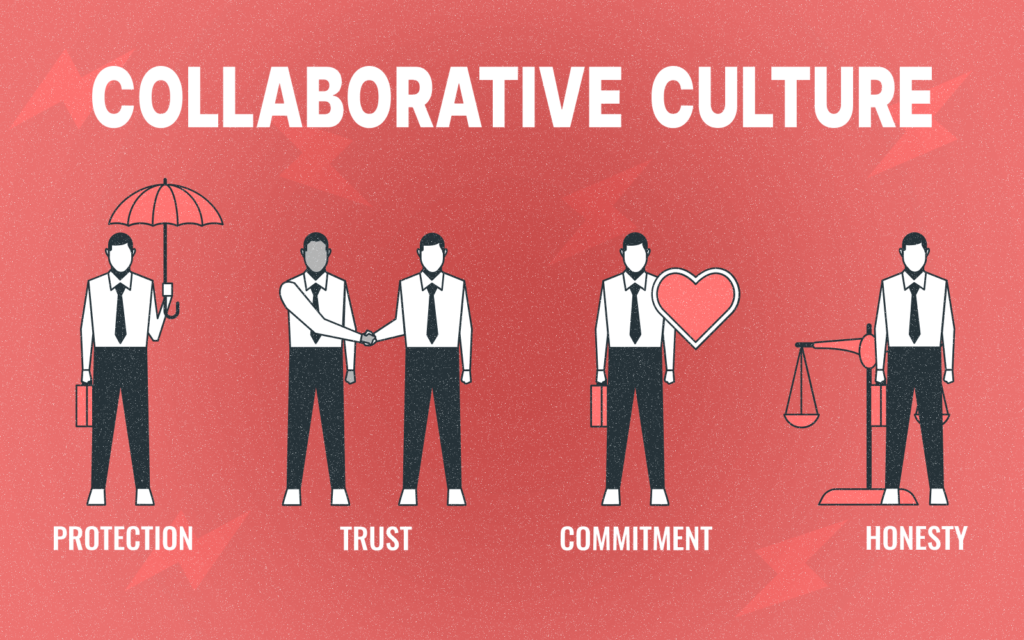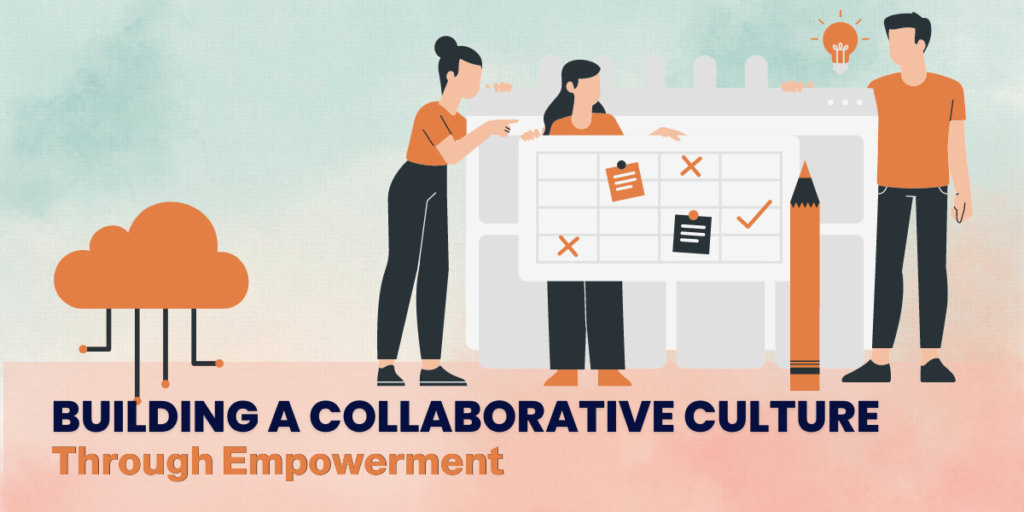Building a Collaborative Culture Through Empowerment


In today’s rapidly changing business landscape, organizations must be agile and adaptable to succeed. A collaborative culture is key to building a team that can work together effectively and takes advantage of new opportunities. However, creating such a culture requires more than just a desire to collaborate. It requires a deep commitment to empowerment. Empowering your team members can lead to increased motivation, engagement, and better decision-making.
According to a study by Glassdoor, 53% of employees would stay longer at their company if they felt more empowered.
According to a survey by Fierceinc, 86% of employees and executives cite a lack of collaboration or ineffective communication as the main reason for workplace failures. A Harvard Business Review study found that employees who feel their work environment is collaborative are twice as likely to be engaged and stay with their organization for a long time. Another study found that organizations that promote collaborative working are 5.5 times more likely to be high-performing than those that don’t.
Further, a report by the Harvard Business Review found that employees who feel empowered to make decisions and take action are more productive, engaged, and satisfied with their jobs.
These statistics demonstrate the significant impact that a collaborative culture can have on the success and productivity of an organization, as well as the job satisfaction and engagement of employees.
In this blog, we will read more about collaborative culture and employee empowerment and explore the strategies and tools that help build a collaborative culture through empowerment. Keep reading!
What Is a Collaborative Culture?

Imagine a workplace where every employee works towards a common goal, where communication flows freely, and where everyone feels valued and supported. That is the picture of a collaborative culture.
In a collaborative culture, individuals work together to achieve a shared objective. It’s a culture that promotes open communication, mutual respect, and a willingness to listen to different perspectives. This type of culture encourages teamwork, trust, and a sense of community, which leads to increased creativity, innovation, and productivity.
When a collaborative culture is established in the workplace, employees are encouraged to share ideas and information freely, without fear of judgement or criticism. This creates an environment where everyone’s voice is heard, and where ideas can be explored and developed without fear of failure. A study by Deloitte found that companies with a collaborative culture are five times more likely to be high-performing than those without such a culture.
In a collaborative culture, leaders are willing to delegate responsibilities and trust their employees to take ownership of tasks. This fosters a sense of accountability, empowerment, and motivation among team members, leading to increased job satisfaction and a stronger sense of loyalty toward the organisation.
Overall, a collaborative culture encourages teamwork, open communication, and a shared sense of purpose. It creates an environment where employees feel valued and supported, leading to increased creativity, innovation, and productivity.
Understanding Empowerment: What is Employee Empowerment?

Employee empowerment is a workplace concept that focuses on providing employees with the authority and autonomy to make decisions that are beneficial for the business. This means that employees are supported to take initiative and use their skills, knowledge, and expertise as well as their insight into customer needs to lead projects and operations. Employers who follow this method benefit from greater employee engagement, increased motivation, improved morale, and ultimately, improved performance. By granting workers the tools they need to learn new skills and encourage innovation in their roles, employee empowerment is an invaluable tool for any organisation. According to a study, 85% of employees are most motivated when internal communication is effective!
Sergio Fernandez and Tima Moldogaziev’s research suggests that employee empowerment can be an effective tool for boosting job satisfaction, organisational commitment, innovativeness, and performance. Moreover, researchers have evaluated the influence of employee authorization on job-related attitudes.
Empowerment means giving your team members the tools and resources they need to make decisions, solve problems, and innovate. Empowerment can lead to increased productivity, improved customer satisfaction, and more creative solutions to complex problems. Empowerment creates a sense of ownership and commitment among team members and can be a powerful motivator.
Steps to Build a Collaborative Culture Through Empowerment

As we read above, employee empowerment is an important step in creating a collaborative culture. Here are some steps you can take to empower your team and foster collaboration:
Building a collaborative culture requires a clear understanding of the team’s goals and objectives. This begins with creating a shared vision and goals that are understood and agreed upon by all team members. When team members have a clear sense of direction and purpose, they are more likely to collaborate effectively.
When asked to identify the most important characteristics of effective strategic leaders, 98 percent of the executives listed “a strong sense of vision” first. Meanwhile, 90 percent of the executives expressed serious doubts about their ability to create a vision.

Step 2. Encourage Open Communication
Open communication is essential to building a collaborative culture. Encourage your team members to share their thoughts, ideas, and concerns. Create a safe space where team members can express their opinions without fear of criticism or judgement. This can be done through regular team meetings, one-on-one conversations, or virtual collaboration tools.
Step 3. Promote Trust and Mutual Respect
Trust and mutual respect are the foundation of a collaborative culture. Encourage your team members to develop strong relationships built on trust and respect. This can be done by setting clear expectations for behaviour, recognizing and addressing conflicts quickly, and holding team members accountable for their actions.
You might be surprised to know that 96% of engaged employees trust management and 46% of disengaged employees trust management.
Step 4. Provide Opportunities for Learning and Growth
A team collaboration culture is built on ongoing learning and growth. Provide team members with opportunities to learn new skills and gain experience that will help them better contribute to the team. This can include training opportunities, mentorship programs, or cross-training initiatives.
Empowerment requires a commitment to ongoing learning and growth. Encourage your team members to seek out new challenges and opportunities to develop their skills. Provide training, mentorship, and coaching to help team members grow and develop.
Step 5. Recognize and Reward Collaboration
Collaboration should be recognized and rewarded to reinforce its importance. This can be done through formal recognition programs or informal praise and acknowledgment. Celebrate team successes and encourage team members to recognize and support each other.
55% of all employees surveyed said they want to leave their jobs. Most of them cited a lack of recognition from their current employer as the main reason. 69% of them said that better employee rewards would encourage them to work longer hours.
Get more out of your business
Get the best employee engagement content every week via mailing list
Strategies for Empowerment
To ensure a truly collaborative company culture, organizations need to provide their team members with the right tools and resources. Workplace collaboration tools can help teams stay connected and work together more effectively.
Gallup estimates that an empowered and motivated employee increases profits by 21%, increases sales by 20%, and reduces safety incidents by 70%.
The following strategies can be used to empower collaborative cultures:
1. Delegation of Authority
Delegating authority to team members can be a powerful way to empower them. Giving team members decision-making power can lead to increased engagement and commitment.
2. Training and Development
One of the strategies for empowering employees is providing them with training and development opportunities. This can include online courses, seminars, or workshops to help team members develop new skills and increase their knowledge.
3. Flexible Working Practices
One of the effective ways to empower employees and promote collaboration is flexible working practices. This can include flexible hours, remote working options, or more autonomy for decision-making.
4. Performance Feedback and Evaluation
Regular performance feedback and evaluation can help team members understand how they are doing and what they need to improve. This can be done through regular check-ins, goal setting, and ongoing coaching.
5. Team Building Activities

You might have already experienced that team-building activities can help build a collaborative culture by fostering strong relationships and trust among team members. This can be done through team-building exercises, offsite retreats, or social events. New team members can also be introduced to the team through informal activities.
6. Recognition and Rewards
Recognition and rewards can reinforce the importance of collaboration and empowerment by encouraging collaboration. This can be done through formal recognition programs, bonuses, or promotions. HR managers create a collaborative culture by recognizing and rewarding team members for their efforts.
Creating a collaborative, empowered culture requires commitment and effort on the part of leaders and managers.
Overcoming Challenges to Empowerment

Empowerment can be challenging to implement, particularly in organisations with entrenched hierarchical structures. Here are some strategies for overcoming common challenges to empowerment:
1. Fear of Losing Control
Managers may resist empowerment because they fear losing control. To overcome this, managers should communicate the benefits of empowerment and provide support and guidance to team members as they take on more responsibility. Managers should also set clear expectations for decision-making and hold team members accountable for their actions.
2. Lack of Trust
Building trust takes time and effort. Managers can overcome a lack of trust by being transparent in their communication, acknowledging mistakes, and following through on commitments. Managers should also provide opportunities for team members to build relationships and develop trust over time.
Organizational trust and empowerment leadership accounted for 68% of the variance in employee mental safety. The three antecedents (i.e. organisational trust, strong leadership, and psychological security) account for 20% of the variation in group conflicts.

3. Resistance to Change
Empowerment may require changes to the way work is done. Resistance to change can be overcome by involving team members in the decision-making process and communicating the benefits of change. Managers should also provide training and support to help team members adapt to new ways of working.
4. Misalignment of Goals and Objectives
Empowerment works best when team members are aligned around shared goals and objectives. Misalignment can be overcome by creating a shared vision and goals, and by regularly communicating progress and priorities.
5. Poor Communication

It is clear that poor communication can prevent team members from developing trust, understanding expectations, and working together. To overcome this, managers should ensure clear lines of communication between team members, provide regular feedback and updates, and encourage dialogue among team members to ensure a truly collaborative workplace. An effective team communication strategy should include a mix of formal and informal methods to ensure all team members are heard.
These strategies can help create an empowered, collaborative culture where team members feel trusted and valued.
Conclusion
Empowerment is a powerful tool for creating collaborative cultures that drive innovation and performance. By delegating authority, providing training and development opportunities, offering performance feedback and evaluation, engaging in team-building activities, and recognizing and rewarding team members, organisations can create an environment of collaboration and trust that is necessary for true empowerment. However, organisations must be prepared to overcome common challenges, including fear of losing control, lack of trust, resistance to change, misalignment of goals and objectives, and poor communication. With the right strategies and support, organisations can successfully empower their teams and drive performance.


